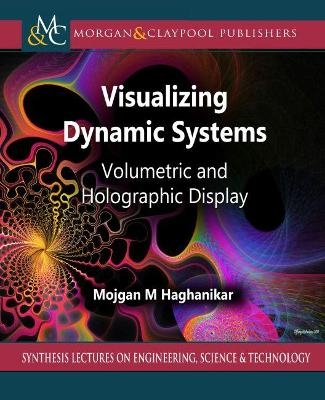
Visualizing Dynamic Systems
Volumetric and Holographic Display
Seiten
2021
Morgan & Claypool Publishers (Verlag)
978-1-63639-137-3 (ISBN)
Morgan & Claypool Publishers (Verlag)
978-1-63639-137-3 (ISBN)
- Lieferbar
- Versandkostenfrei
- Auch auf Rechnung
- Artikel merken
Offers a leap into designing framework for using mixed reality (XR) technologies and cyberlearning in communicating advanced scientific concepts. The intention is to flesh out the cognitive infrastructure and visuospatial demands of complex systems and compare them in various contexts and disciplines.
This book is aimed to help instructional designers, science game designers, science faculty, lab designers, and content developers in designing interactive learning experiences using emerging technologies and cyberlearning. The proposed solutions are for undergraduate and graduate scientific communication, engineering courses, scientific research communication, and workforce training.
Reviewing across the science education literature reveals various aspects of unresolved challenges or inabilities in the visualization of scientific concepts. Visuospatial thinking is the fundamental part of learning sciences; however, promoting spatial thinking has not been emphasized enough in the educational system (Hegarty, 2014). Cognitive scientists distinguish between the multiple aspects of spatial ability and stresse that various problems or disciplines require different types of spatial skills. For example, the spatial ability to visualize anatomy cross-sections is significantly associated with mental rotation skills. The same is true for physical problems that often deal with spatial representations. However, most of the physics problems are marked by dynamicity, and visualizing dynamicity is inferred by the integrations of different participating components in the system. Therefore, what is needed for learning dynamicity is visualizing the mental animation of static episodes.
This book is a leap into designing framework for using mixed reality (XR) technologies and cyberlearning in communicating advanced scientific concepts. The intention is to flesh out the cognitive infrastructure and visuospatial demands of complex systems and compare them in various contexts and disciplines. The practical implementation of emerging technology can be achieved by foreseeing each XR technology's affordances and mapping those out to the cognitive infrastructure and visuospatial demands of the content under development.
This book is aimed to help instructional designers, science game designers, science faculty, lab designers, and content developers in designing interactive learning experiences using emerging technologies and cyberlearning. The proposed solutions are for undergraduate and graduate scientific communication, engineering courses, scientific research communication, and workforce training.
Reviewing across the science education literature reveals various aspects of unresolved challenges or inabilities in the visualization of scientific concepts. Visuospatial thinking is the fundamental part of learning sciences; however, promoting spatial thinking has not been emphasized enough in the educational system (Hegarty, 2014). Cognitive scientists distinguish between the multiple aspects of spatial ability and stresse that various problems or disciplines require different types of spatial skills. For example, the spatial ability to visualize anatomy cross-sections is significantly associated with mental rotation skills. The same is true for physical problems that often deal with spatial representations. However, most of the physics problems are marked by dynamicity, and visualizing dynamicity is inferred by the integrations of different participating components in the system. Therefore, what is needed for learning dynamicity is visualizing the mental animation of static episodes.
This book is a leap into designing framework for using mixed reality (XR) technologies and cyberlearning in communicating advanced scientific concepts. The intention is to flesh out the cognitive infrastructure and visuospatial demands of complex systems and compare them in various contexts and disciplines. The practical implementation of emerging technology can be achieved by foreseeing each XR technology's affordances and mapping those out to the cognitive infrastructure and visuospatial demands of the content under development.
Acknowledgments
Introduction
Overview of Chapters
The Art of Thinking About Complex Systems
Spatial Abilities and Success in Sciences
Science Education Literature on Visualization
EdTech Solutions
Emerging Technologies: A Twist on EdTech Solutions
Curriculum Design and Emerging Technologies
Breakthroughs in Scientific Communication
References
Author Biography
| Erscheinungsdatum | 21.06.2021 |
|---|---|
| Reihe/Serie | Synthesis Lectures on Engineering, Science, and Technology |
| Verlagsort | San Rafael |
| Sprache | englisch |
| Maße | 191 x 235 mm |
| Themenwelt | Mathematik / Informatik ► Informatik ► Datenbanken |
| Informatik ► Software Entwicklung ► User Interfaces (HCI) | |
| Mathematik / Informatik ► Informatik ► Web / Internet | |
| Sozialwissenschaften ► Pädagogik | |
| ISBN-10 | 1-63639-137-0 / 1636391370 |
| ISBN-13 | 978-1-63639-137-3 / 9781636391373 |
| Zustand | Neuware |
| Haben Sie eine Frage zum Produkt? |
Mehr entdecken
aus dem Bereich
aus dem Bereich
Aus- und Weiterbildung nach iSAQB-Standard zum Certified Professional …
Buch | Hardcover (2023)
dpunkt Verlag
CHF 48,85
Lean UX und Design Thinking: Teambasierte Entwicklung …
Buch | Hardcover (2022)
dpunkt (Verlag)
CHF 48,85
Wissensverarbeitung - Neuronale Netze
Buch | Hardcover (2023)
Carl Hanser (Verlag)
CHF 48,95


